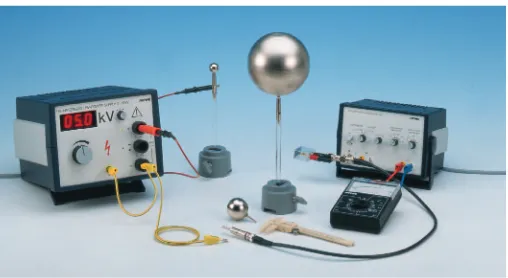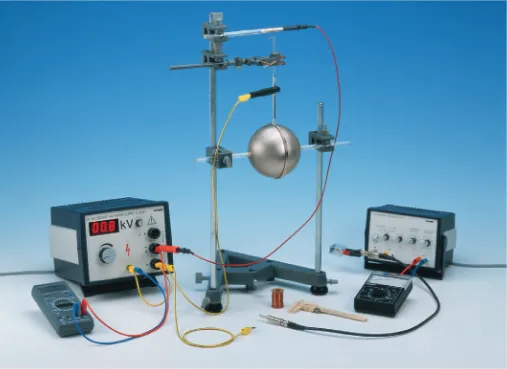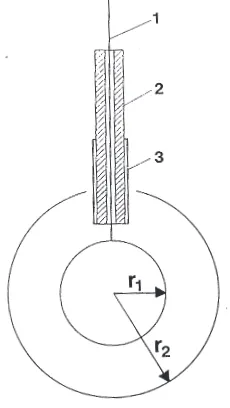Principle:
Metal spheres with different radii and a spherical capacitor are charged by means of a variable volt-age. The induced charges are deter-mined with a measuring amplifier. The corresponding capacitances are deduced from voltage and charge values.
Tasks:
1. Determination of the capacitance of three metal spheres with differ-ent diameters.
2. Determination of the capacitance of a spherical capacitor.
U1(measured voltage) as a function of U2(charging voltage) measured on
conducting spheres with three different diameters.
3. Determination of the diameters of each test body and calculation of their capacitance values.
What you can learn about …
Voltage Conductor ball, d= 120 mm 06238.00 1 Hemispheres, Cavendish type 06273.00 1 Hollow plastics ball, w. eyelet 06245.00 1 Capillary tube, straight, l= 250 mm 36709.00 1 Copper wire, d= 0.5 mm, l= 50 m 06106.03 1
Insulating stem 06021.00 2
High-value resistor, 10 MΩ 07160.00 1 High voltage supply unit, 0-10 kV 13670.93 1 Capacitor/ case 1/ 10 nF 39105.14 1 Universal measuring amplifier 13626.93 1
Multi-range meter A 07028.01 1
Digital multimeter 07134.00 1
Connecting cord, 30 kV, l= 1000 mm 07367.00 1 Screened cable, BNC, l= 750 mm 07542.11 1 Adapter, BNC socket - 4 mm plug 07542.20 1 Connector, T type, BNC 07542.21 1 Adapter, BNC-plug/socket 4 mm 07542.26 1 Vernier caliper, plastic 03014.00 1
Barrel base -PASS- 02006.55 2
Support base -PASS- 02005.55 1
Right angle clamp -PASS- 02040.55 4 Support rod -PASS-, square, l= 630 mm 02027.55 1 Support rod -PASS-, square, l= 400 mm 02026.55 1 Universal clamp with joint 37716.00 1 Croco. clip, insul., strong, 10 pcs 29426.03 1 Connecting cord, l= 100 mm, green-yellow 07359.15 1 Connecting cord, l= 750 mm, green-yellow 07362.15 2 Connecting cord, l= 500 mm, blue 07361.04 2 Connecting cord, l= 500 mm, red 07361.01 2
What you need:
PHYWE series of publications • Laboratory Experiments • Physics • © PHYWE SYSTEME GMBH & Co. KG • D-37070 Göttingen 24203-00 1
Related topics
Voltage, potential, charge, electric field, electrostatic induc-tion, electrostatic induction constant, capacitance, capaci-tors, dielectrics.
Principle
Metal spheres with different radii and a spherical capacitor are charged by means of a variable voltage. The induced charges are determined with a measuring amplifier. The corresponding capacitances are deduced from voltage and charge values.
Equipment
Conductor ball, d= 20 mm 06236.00 2
Conductor ball, d= 40 mm 06237.00 1
Conductor ball, d= 120 mm 06238.00 1
Hemispheres, Cavendish type 06273.00 1
Hollow plastics ball, w. eyelet 06245.00 1
Capillary tube, straight, l= 250 mm 36709.00 1
Copper wire, d= 0.5 mm, l= 50 m 06106.03 1
Insulating stem 06021.00 2
High-value resistor, 10 MOhm 07160.00 1
High voltage supply unit, 0-10 kV 13670.93 1
Capacitor/ case 1/ 10 nF 39105.14 1
Universal measuring amplifier 13626.93 1
Multi-range meter A 07028.01 1
Digital multimeter 07134.00 1
Connecting cord, 30 kV, l= 1000 mm 07367.00 1
Screened cable, BNC, l= 750 mm 07542.11 1
Adapter, BNC socket - 4 mm plug 07542.20 1
Connector, T type, BNC 07542.21 1
Adapter, BNC-plug/socket 4 mm 07542.26 1
Vernier caliper, plastic 03014.00 1
Barrel base -PASS- 02006.55 2
Support base -PASS- 02005.55 1
Right angle clamp -PASS- 02040.55 4
Support rod -PASS-, square, l= 630 mm 02027.55 1
Support rod -PASS-, square, l= 400 mm 02026.55 1
Universal clamp with joint 37716.00 1
Croco. clip, insul., strong, 10 pcs 29426.03 1
Connecting cord, l= 100 mm, green-yellow 07359.15 1
Connecting cord, l= 750 mm, green-yellow 07362.15 2
Connecting cord, l= 500 mm, blue 07361.04 2
Connecting cord, l= 500 mm, red 07361.01 2
Tasks
1. Determination of the capacitance of three metal spheres with different diameters.
2. Determination of the capacitance of a spherical capacitor. 3. Determination of the diameters of each test body and
cal-culation of their capacitance values.
Set-up and Procedure Part 1:
The experimental set-up to determine the capacitance of spherical conductors is shown in Fig. 1. Fig. 2 only shows the part of the experimental set-up which must be modified in order to determine the capacitance of a spherical capacitor.
The spherical conductor (d= 2 cm) held on a barrel base and
insulated against the latter is connected by means of the high
voltage cord over the 10 MΩ- protective resistor to the
positi-ve pole of the 10 kV output of the high voltage power supply. The negative pole is earthed. This sphere is briefly brought into contact with the test spheres to charge it. High voltage always must be reset to zero after charging. After every meas-urement, the charging voltage is increased by 1 kV. Before
being charged anew, the test spheres must be discharged through contact with the free earth connecting cable. The charges of the test spheres are determined with a meas-uring amplifier. The high-resistance input of the electrometer is used for this. An auxiliary 10 nF capacitor is connected in par-allel to the BNC test cord fitted with the adapter required to take over the charge.
The capacitances of the spherical conductors are determined from the voltage and charge values; this is done using the average calculated over a number of charge measurement values.
Never apply high voltage to the amplifier input.
Part 2:
To determine the capacitance of a spherical capacitor, the experimental set-up is altered as shown in Fig. 2. The Cavendish hemispheres are put together so as to form a com-plete sphere with a small circular orifice at the top.
The plastic sphere with conducting surface is suspended from a copper wire in the centre of the sphere. The copper wire is lead through a glass capillary tube which is wrapped in earth-ed aluminium foil to neutralise stray capacitances (Fig. 3). The aluminium foil may not touch the hemispheres.
The interior sphere must be connected to the central socket of the high voltage power supply. This is done by means of a cro-codile clip over the high voltage cord, before which a
10 MΩ protective resistor is connected. The lower socket is
earthed again.
Voltage is increased in steps of 100 V and may notincrease
above 1000 V for the safety of the digital multimeter. The cor-responding mean values of the charges are read determined for the hemispheres similarly as described in Part. After every measurement, the hemispheres must be discharged with the free earthing cord. Whilst doing this, it must be assured that no high voltage is induced.
Theory and evaluation Part 1:
The capacitance Cof a sphere with radius Ris given by:
C= 4Qa
0R (electrostatic induction constant
a0= 8.86 · 10-12As/Vm ) (1)
Using (1), the capacitance of the conducting spheres may be calculated:
Sphere (2R1= 0.121 m) : C= 6.7 · 10-12As/V = 6.70 pF
Sphere (2R2= 0.041 m) : C= 2.28 · 10-12As/V = 2.28 pF
Sphere (2R3= 0.021 m) : C= 1.22 · 10-12As/V = 1.22 pF
Using (2), the voltage values U1, which were determined by means of the measuring amplifier, allow to determine the
cor-responding charge value Q:
Q= (Cco+ Cca) U1= (Cco+ Cca) ;
with Cco<< Cca; Q= CcaU1= (2)
(Cco= capacitance of the conductors;
Cca= capacitance of the parallel capacitor,
U = displayed voltage, V= amplification factor,
U1 = measured voltage)
On the other hand, the charge Qof the conductor is:
Q= CcoU2 (3)
Finally, charges may be calculated using (2) and (3).
U1/ U2= Cco/ Cca
Fig. 4 shows charging voltage values U2 as a function of
measurement voltage U1for the different conducting spheres.
With the slope of the lines and knowing Cca, the capacitances
of the conducting spheres are obtained:
C(R1) = 7.55 pF; C(R2) = 2.33 pF; C(R3) = 1.32 pF
(With the assistance of a measuring bridge, the capacitance
Ccaof the parallel capacitor was determined separately to be
Cca= 9.1 nF. If exact capacitance determination is impossible,
the nominal capacitance value of the capacitor must be used for calculation; this may, however, be affected by design tole-rance deviations of ± 10%).
Part 2:
The capacitance Cof a spherical capacitor is given by
(4)
(r1= Radius of the interior sphere;
r2= Radius of the exterior sphere)
With r1= 0.019 m and r2= 0.062 m for the spherical
capaci-tors, capacitance calculation yields C= 3.0 pF.
Fig. 5 once more represents measurement value pairs U1and
U2.
According to the assessment procedure described above and using the slope of the graph line, the empirically determined capacitance of the spherical capacitor is found to be
C= 3 .5 pF.
Capacitance values determined experimentally are always higher than the calculated values. This discrepancy is due to unavoidable dispersive capacitances.
C4pe0 a r1r2 r2r1b
;
U V U V
PHYWE series of publications • Laboratory Experiments • Physics • © PHYWE SYSTEME GMBH & Co. KG • D-37070 Göttingen 24203-00 3
Fig. 3: Sketch showing set-up and the attachment of conduc-ting spheres.
(1= Copper wire; 2 = capillary tube; 3 = aluminium foil)
Fig. 4: U1as a function of U2measured on conducting
sphe-res with three different diameters.
Fig. 5: U1as a function of U2 measured on a spherical


